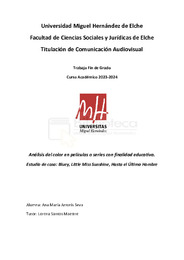Please use this identifier to cite or link to this item:
https://hdl.handle.net/11000/33335Análisis del color en películas o series con finalidad educativa. Estudio de caso: Bluey, Little Miss Sunshine, Hasta el Último Hombre
| Title: Análisis del color en películas o series con finalidad educativa. Estudio de caso: Bluey, Little Miss Sunshine, Hasta el Último Hombre |
| Authors: Arronis Seva, Ana María |
| Tutor: Santos-Maestre, Lorena |
| Editor: Universidad Miguel Hernández de Elche |
| Department: Departamentos de la UMH::Ciencias Sociales y Humanas |
| Issue Date: 2024-06 |
| URI: https://hdl.handle.net/11000/33335 |
| Abstract: El estudio del color relacionado con la psicología es un campo amplio y fascinante que abarca diversas disciplinas, incluyendo el arte, el diseño, el marketing y la psicología misma. El color no solo es una parte integral de la percepción visual, sino que también tiene la capacidad de evocar emociones, influir en el comportamiento y comunicar mensajes de manera poderosa y bella. Siguiendo esta idea, este Trabajo de Fin de Grado (TFG) explora la psicología del color y su significativa influencia en el cine para transmitir emociones y construir narrativas visuales. Se examinan los principios fundamentales de la teoría del color y cómo diferentes tonos pueden evocar respuestas emocionales específicas en los espectadores. Además, se destacan estudios psicológicos que demuestran cómo los colores pueden afectar el estado de ánimo, las percepciones y las reacciones del público, proporcionando una base teórica sólida para entender su impacto en el cine. Para el desarrollo de la investigación se han escogido como casos de estudio tres ejemplos específicos de películas que utilizan el color de manera efectiva para desarrollar personajes, establecer atmósferas y resaltar temas centrales: Bluey (Joe Brumm, 2018), Little Miss Sunshine (Valerie Faris, Jonathan Dayton, 2006) y Hasta el Último Hombre (Mel Gibson, 2016). A través de estas obras no solo se estudia la estética que acompaña a la narrativa de cada una de ellas, sino que también se resalta la importancia de los mensajes que estas transmiten, ya que son producciones que cuentan historias profundas y pretenden aportar valor a su público. Finalmente, se discute la aplicación práctica de estos conocimientos en la producción cinematográfica actual. Se proponen tendencias futuras de producción sobre cómo se seguirá utilizando el color de manera intencional para mejorar la narrativa y la experiencia del espectador. El trabajo concluye subrayando la importancia del color y como, manejando su psicología, puede ser una herramienta poderosa y versátil en el cine, capaz de enriquecer la narrativa propuesta por el director y de influir profundamente en las emociones del espectador. The study of colour as it relates to psychology is a fascinating field that tackle several disciplines, including art, design, marketing and psychology itself. Colour is not only an integral part of visual perception, but also has the ability to call up emotions, influence behaviour and communicate messages in powerful and beautiful ways. Following this idea, this dissertation explores the psychology of colour and its significant influence in cinema to convey emotions and construct visual narratives. It examines the fundamental principles of colour theory and how different tones are able to cause specific emotional responses in viewers. In addition, it highlights psychological studies that demonstrate how colours can affect the mood, perceptions and reactions of audiences, providing a solid theoretical basis for understanding their impact on cinema. For the development of the research, three specific examples of films have been chosen because they use colour effectively to develop characters, establish atmospheres and highlight central themes: Bluey (Joe Brumm, 2018), Little Miss Sunshine (Valerie Faris, Jonathan Dayton, 2006) and Hacksaw Ridge (Mel Gibson, 2016). Through these works we not only study the aesthetics of each of them, but also highlight the importance of the messages they convey, as they are productions that tell profound stories and have the aim to bring value to their audiences. Finally, the practical application of this knowledge in current film production is discussed. Future production trends are proposed on how colour will continue to be used intentionally to enhance the narrative and the viewer's experience. This dissertation concludes by emphasizing the importance of colour and how, by managing its psychologically, it can be a powerful and versatile tool in cinema, capable of enriching the narrative proposed by the director and profoundly influencing the viewer's emotions. |
| Keywords/Subjects: Cine color psicología del color audiovisual emociones Filmmaking psychology of color emotions |
| Knowledge area: CDU: Bellas artes: Fotografía. Cinematografía |
| Type of document: info:eu-repo/semantics/bachelorThesis |
| Access rights: info:eu-repo/semantics/openAccess Attribution-NonCommercial-NoDerivatives 4.0 Internacional |
| Appears in Collections: TFG - Doble Grado en Comunicación Audiovisual y Periodismo |
.png)

